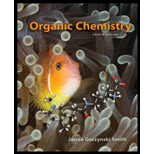
Like alcohols, ethers undergo Α cleavage by breaking a carbon–carbon bond between an alkyl group and the carbon bonded to the ether oxy gen atom; that is, the red
Want to see the full answer?
Check out a sample textbook solution
Chapter 13 Solutions
Package: Organic Chemistry With Connect 2-semester Access Card
Additional Science Textbook Solutions
Thermodynamics, Statistical Thermodynamics, & Kinetics
Fundamentals of Heat and Mass Transfer
Chemistry (7th Edition)
Organic Chemistry
EBK INTRODUCTION TO CHEMISTRY
Chemistry: The Molecular Nature of Matter
- Recalling the reactions of alcohols from Chapter 10, show how to synthesize each compound from an organohalogen compound and an oxirane, followed by a transformation of the resulting hydroxyl group to the desired oxygen-containing functional group.arrow_forwardWhich compound is an alcohol that may be oxidized to a carboxylic acid by Na2Cr2O7/H2SO4? Of the seven compounds shown here, which is more acidic? Which compound easily rearranges to a ketone in acidic or basic media?arrow_forwardAlkenes can be hydrated to form alcohols by (1) hydroboration followed by oxidation with alkaline hydrogen peroxide and (2) acid-catalyzed hydration. Compare the product formed from each alkene by sequence (1) with those formed from (2). Q.)1-Methylcyclohexenearrow_forward
- Three constitutional isomers of molecular formula C 5H 8O can be converted to 1-pentanol (CH 3CH 2CH 2CH 2CH 2OH) on treatment with two equivalents of H 2 in the presence of a Pd catalyst. Draw the structures of the three possible compounds, all of which contain a carbonyl grouparrow_forwardDraw structural formulas for the alkenes formed by acid-catalyzed dehydration of each alcohol. Where isomeric alkenes are possible, predict which is the major product. Q.) 1-Methylcyclopentanolarrow_forwardA compound X of molecular formula C7H14 when hydrogenated produces 2,4-dimethylpentane and when hydroborated the obtained alcohol is 2,4-dimethyl-1-pentanol. a. What is the structure of X? b. If X is reacted with H2O catalyzed by H2SO4, what product is obtained? Write the structure, give the name, and write the complete mechanism, step by step of this reaction, in such a way as to explain the formation of the compound (DO NOT FORGET THE CORRECT USE OF ARROWS!).arrow_forward
- If 1-bromopentane is heated in acetone containing NaOH, what is the alkane produced? Draw and explain the step-by-step mechanism of the production of the compoundarrow_forwardBased on the following H NMR and IR spectrums, what is the structure of C9H8O4?arrow_forwardDraw the structure of two alkenes that would yield 1‑methylcyclohexanol when treated with Hg(OAc)2Hg(OAc)2 in water, then NaBH4NaBH4arrow_forward
- The reaction of p-cresol with CH2=O resembles the reaction of phenol (PhOH) with CH2=O, except that the resulting polymer is thermoplastic but not thermosetting. Draw the structure of the polymer formed, and explain why the properties of these two polymers are so different.arrow_forwardExplain mechanism - Base-Catalyzed Addition of H2O to a Carbonyl Group ?arrow_forwardName and draw the structure of the major product in the following reactions of cyclohexanone: A) Reduction with NaBH4 in ethanol, followed by H+ B) Reaction with excess ethanol in the presence of H+arrow_forward

 Organic ChemistryChemistryISBN:9781305580350Author:William H. Brown, Brent L. Iverson, Eric Anslyn, Christopher S. FootePublisher:Cengage Learning
Organic ChemistryChemistryISBN:9781305580350Author:William H. Brown, Brent L. Iverson, Eric Anslyn, Christopher S. FootePublisher:Cengage Learning

